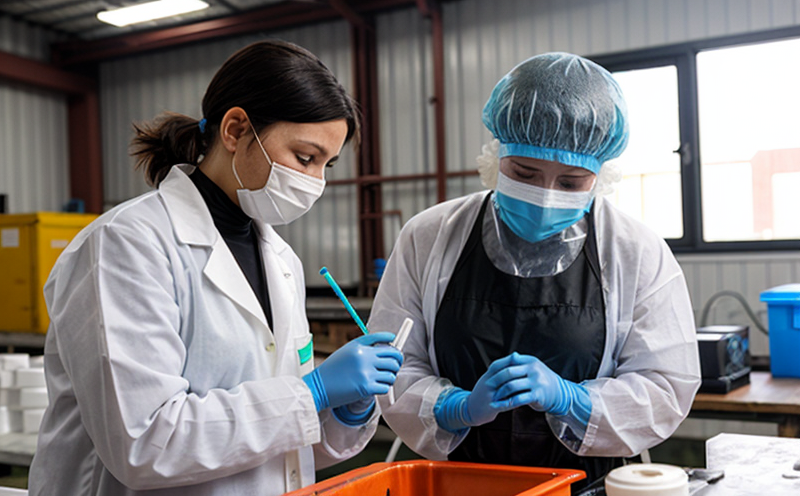ISO 10993-17 Risk Assessment of Leachables from Recycled Nanomaterials
The ISO 10993-17 standard is a pivotal framework for the risk assessment of leachable and extractable substances in medical devices. This service focuses on the evaluation of leachables from recycled nanomaterials used in various applications, ensuring they meet stringent regulatory requirements and are safe for human use.
The process involves multiple stages, starting with material characterization to understand the composition of recycled nanomaterials. Subsequently, extraction procedures simulate real-world exposure conditions to identify potential leachables. Once identified, these substances undergo comprehensive testing using a variety of analytical methods to assess their toxicity and biocompatibility.
The significance of this service lies in its role in ensuring that recycled nanomaterials are as safe as virgin materials. This is crucial given the increasing demand for sustainable alternatives without compromising on product safety or efficacy. The service not only adheres to ISO 10993-17 but also extends beyond compliance by providing insights into potential risks and mitigation strategies.
A critical aspect of this service is the use of advanced analytical techniques such as High-Performance Liquid Chromatography (HPLC), Inductively Coupled Plasma Mass Spectrometry (ICP-MS), and Fourier Transform Infrared Spectroscopy (FTIR). These methods ensure precision in identifying even trace amounts of leachables, thereby enhancing the reliability of the assessment.
The risk assessment process involves a series of tests to evaluate the potential adverse effects of identified leachables on human health. This includes determining the maximum allowable concentration levels and assessing whether these substances can cause irritation or toxicity. The service also provides recommendations for minimizing risks through appropriate design, manufacturing processes, and material selection.
The importance of this service extends beyond regulatory compliance; it plays a vital role in maintaining brand reputation and patient safety. By adhering to the highest standards of quality assurance and reliability, we ensure that recycled nanomaterials are fit for purpose and meet stringent international standards such as ISO 10993-17.
To further illustrate the scope and methodology of this service, let's consider a typical project involving the assessment of leachables from recycled carbon nanotubes used in orthopedic implants. The process begins with detailed material characterization to identify potential contaminants or additives that could influence the extraction profile. Extraction is then performed using simulated physiological fluids under controlled conditions.
Following extraction, the resulting solutions are analyzed using a combination of HPLC and FTIR to identify and quantify leachable compounds. This data is then used in conjunction with toxicological assessments to determine if any identified substances pose a risk. Based on these findings, specific recommendations can be made regarding material sourcing or processing methods.
The service also includes a detailed report summarizing all test results and conclusions drawn from the assessment. This report serves as a valuable resource for manufacturers looking to ensure compliance with regulatory requirements while also enhancing product safety and performance.
Applied Standards
| Standard | Description |
|---|---|
| ISO 10993-17 | Risk assessment of leachables and extractables from medical devices. |
| ASTM E2586 | Standard practice for conducting in vitro cytotoxicity tests using cultured cells. |
The ISO 10993-17 standard provides a comprehensive framework for assessing the risks associated with leachables from recycled nanomaterials. This includes not only identifying potential contaminants but also evaluating their biocompatibility and toxicity. The ASTM E2586 standard complements this by offering guidelines on conducting in vitro cytotoxicity tests, which are essential for understanding the biological impact of identified substances.
Quality and Reliability Assurance
- Compliance with ISO 10993-17
- Use of advanced analytical techniques for precise identification of leachables
- Conducting in vitro cytotoxicity tests to evaluate biocompatibility
- Providing detailed reports summarizing all test results and conclusions
The quality and reliability assurance process begins with meticulous adherence to ISO 10993-17, ensuring that every step of the evaluation adheres to internationally recognized standards. Advanced analytical techniques such as HPLC, ICP-MS, and FTIR provide high levels of precision in identifying even trace amounts of leachables. In vitro cytotoxicity tests further enhance reliability by simulating real-world conditions to assess potential adverse effects.
Our commitment to quality is reflected in the detailed reports we generate, which summarize all test results and conclusions drawn from the assessment. These reports serve as a valuable resource for manufacturers looking to ensure compliance with regulatory requirements while also enhancing product safety and performance. By providing comprehensive data and expert insights, we help clients make informed decisions about material selection and process optimization.
Competitive Advantage and Market Impact
- Pioneering the use of recycled nanomaterials in medical devices
- Ensuring compliance with stringent regulatory requirements
- Providing insights into potential risks and mitigation strategies
The implementation of this service offers significant competitive advantages by allowing manufacturers to stay ahead of regulatory changes while also contributing to environmental sustainability. By ensuring compliance with ISO 10993-17, companies can demonstrate their commitment to product safety and quality, thereby enhancing brand reputation.
Our service provides more than just compliance; it offers valuable insights into potential risks and mitigation strategies that can influence design and manufacturing decisions. This proactive approach not only helps in meeting regulatory requirements but also ensures that products are safe and effective for their intended use. By leading the way in recycled nanomaterials testing, we help our clients gain a competitive edge in an increasingly environmentally conscious market.





